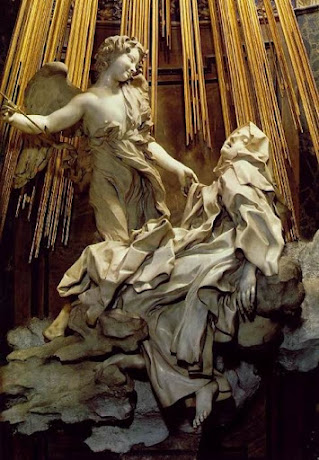During the Classical Era of art, there were two styles of art that were most often used by artists during this time. These styles consisted of the rococo style and the neoclassical style. The neoclassical style was focused on conveying moral narratives and telling a story to the viewer through the painting.
The Death of Socrates by Jacques Louis David (1787).
The piece painted by David that is displayed above is a piece that follows the guidelines of a neoclassical painting and was painted in Paris in 1787. This piece conveys a moral narrative and uses the vibrant colors and contrasting light to convey this moral story. The painting depicts the ancient Greek philosopher, Socrates, being sentenced to death for teaching his unorthodox beliefs (The Death of Socrates). Although Socrates himself did not have completely morally sound views, which is what neoclassical art made an importance of, the painting is still able to portray morality to the viewer. By illustrating this death sentence, and with the background knowledge and understanding of Socrates beliefs, David was able to show the issue with the things that Socrates was teaching and therefore display why you should have more sound morals in this artwork.
I find this piece to be quite saddening so I would not personally own it especially since it is also of a man being sentenced to death. I would still admire and look at the piece in a museum as well as appreciate and hope to understand more about the historical context of the piece.

The Apotheosis of Homer by Jean-Auguste-Dominique Ingres (1827).
The piece above is a neoclassical painting by Ingres that was painted in Louvre, Paris in 1827. In the piece, Ingres has used vibrant colors that make the piece very visually appealing while also creating a scene that conveys a clear story. The use of structural and environmental details help a viewer understand where the scene is taking place, in this painting that is in Greece which is indicated by the Greek temple in the background (“The Apotheosis of Homer.”). At the center of this piece, the poet Homer is being crowned by a winged figure called Nike (“The Apotheosis of Homer.”). Through many of Homer's poetry, specifically in writings such as Odysseus and The Iliad, he writes about moral narratives and teaches the importance of these morals (Dr. Beth Harris and Dr. Steven Zucker, et al.). By understanding the main figure that is illustrated as well as understanding who some of the other characters are, morality is conveyed through this painting just as Ingres intended.
Overall, I really enjoy looking at this piece. I love the vibrant colors in the background and the bright clothing that many of the figures are wearing. I also love the angel figure, Nike, and the way that they are illustrated. I, however, would not want to own this piece and hang it up in my own home. I would definitely admire it in a museum though.
Jupiter and Mercury at Philemon and Baucis by Andrea Appiani (date unknown).
Above is a painting created by the Italian neoclassical painter, Andrea Appiani and the date by which this painting was made is unknown. This painting illustrates two figures from Roman mythology, the god Jupiter and the wing-footed messenger god, Mercury (Gill, N.S.). The story that this painting is depicting is about how Jupiter wanted to destroy mankind but decided to give it one last chance and disguised himself as a worn out traveler (Gill, N.S.). Jupiter and Mercury traveled around the different houses that neighbored Philemon and Baucis but everyone they saw turned them away, until they got to the final home that belonged to the older couple (Gill, N.S.). Philemon and Baucis treated Jupiter and Mercury with great respects and served the guests with food and made a fire to keep them warm (Gill, N.S.). Upon their acts of kindness and generosity, the gods decided that the couple would be saved so they took them to a mountain nearby and flooded the area while keep the two safe. Appiani chose a great moral story to depict with a great meaning behind it. Besides the Roman mythology and the gods involved, it conveys the popular moral value that you "should not judge a book by it's cover" as well as the moral to treat others the way you want to be treated.
Just as with the other two paintings, I really enjoyed learning about the historical context as well as looking at the composition of the piece and the use of vibrant colors. I would not own the piece but I would certainly look at it with awe as I learn more about it's meaning.
Citations
“The Apotheosis of Homer.” The Apotheosis of Homer by Jean-Auguste-Dominique Ingres, https://www.thehistoryofart.org/jean-auguste-dominique-ingres/apotheosis-of-homer/.
The Death of Socrates - Metcollects - The Metropolitan Museum of Art, https://www.metmuseum.org/art/online-features/metcollects/the-death-of-socrates#:~:text=The%20Neoclassical%20style%20was%20well,Athens%20with%20his%20unorthodox%20ideas.
Dr. Beth Harris and Dr. Steven Zucker, et al. “Jean-Auguste-Dominique Ingres, Apotheosis of Homer.” Smarthistory, https://smarthistory.org/ingres-apotheosis-of-homer/.
Gill, N.S. “What's the Moral of the Myth of Philemon and Baucis?” ThoughtCo, ThoughtCo, 17 Feb. 2019, https://www.thoughtco.com/philemon-and-baucis-112315#:~:text=What%20Is%20the%20Moral%20of,the%20presence%20of%20a%20god.





Comments
Post a Comment